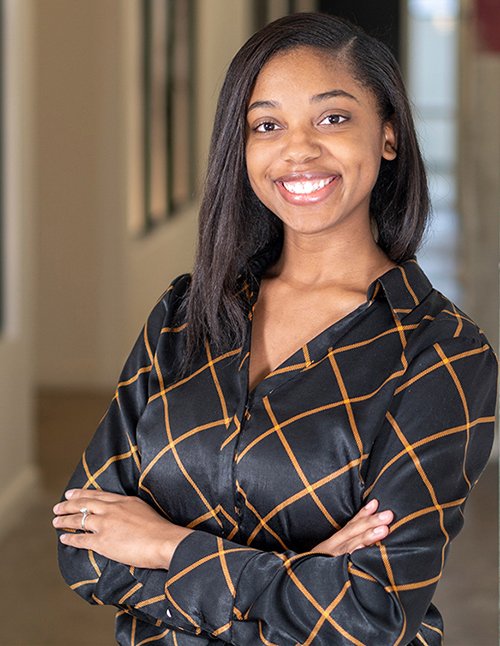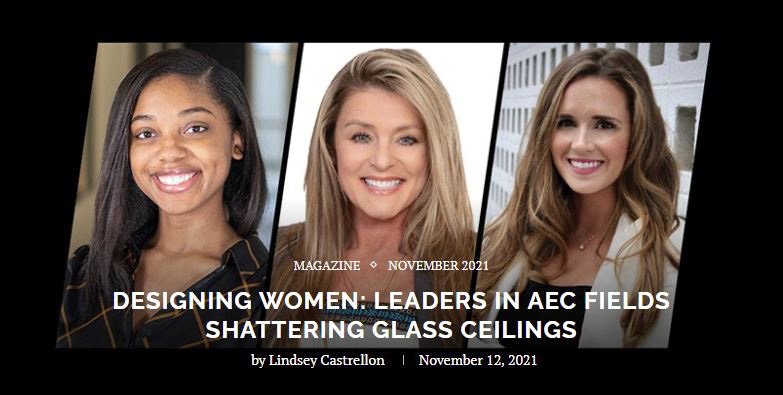It’s no secret that like many other professions, the architecture, engineering and construction industries are predominantly made up of male workers. But more women are stepping into leadership roles in these industries, thanks in part to programs put in place to encourage girls to pursue STEM-related fields and companies making conscious efforts to be more inclusive in the hiring process.
Arkansas Money & Politics visited with three AEC professionals who are using their elevated designing, planning and building skills to shatter the glass ceilings in their respective industries — and replacing them with solid foundations for future female leaders.

Amber Banks, AIA, Architect
Cromwell Architects Engineers
Little Rock
Amber Banks joined Cromwell as an intern in 2015 and began her architectural career with the firm after receiving a Bachelor of Architecture degree from the Fay Jones School of Architecture and Design at the University of Arkansas in 2017. Since joining the Cromwell team, she has worked on a variety of projects including education, military, medical and municipal. A member of the American Institute of Architects, she is an active community volunteer, serving as a board member for International Development Service and as a mentor for North Little Rock W.O.R.K.S.
AMP: Who, or what, inspired you to pursue a career in architecture?
Banks: For as long as I can remember, I have always enjoyed anything that involved drawing, painting and simply making. As a child, I found myself creating different spaces with the tools available to me such as furniture pieces, blankets and toys, but I was completely unaware of the profession of architecture. While in middle school, an older cousin of mine gave me a 3-D modeling program that allowed me to begin transforming my imagination into digital forms. Of course I did not realize it at the time, but my cousin must have noticed the beginnings of a passion for design before I knew it myself. I only knew that I wanted to create better spaces for my family, community and the environment.
Throughout the remainder of middle school and high school, I continued exploring the world of architecture and design, and I eventually began to ask myself: “Is this the career path for me?” Unfortunately, as a senior in high school, there were several people who told me that architecture school was difficult and that I may need to select another major. All of the words of discouragement only increased my self-motivation. Without knowing what architecture school fully entailed, I made the decision to listen to my own voice and I enrolled in the Fay Jones School of Architecture and Design at the University of Arkansas.
AMP: How could you encourage women to be more involved in architecture, engineering and construction?
Banks: The architecture, engineering, and construction industries are still predominantly male, but that does not have to be a reflection of the future. Like many other professions, women may face obstacles in the AEC industries, but I encourage each woman to use every obstacle as a means of self-motivation to move forward.
As a Black female student in architecture school, it was challenging to find others in the school and profession who I could relate to or even feel comfortable discussing some of the difficulties I faced. My own experience in school encouraged me to focus on my studies and graduate so that one day I could potentially become a mentor for someone else in my position. If you are passionate about architecture, engineering or construction, do not let anything or anyone discourage you. Take what some may consider a disadvantage, and use it to better understand a more diverse client base and introduce a new perspective to resolve design issues.
AEC industries give you the opportunity to shape the built environment and how it impacts families and communities. It provides the tools necessary to determine the direction that the environment will move in. It is up to all of us to create a more inclusive profession. I am following my dream of helping those in my surrounding community and hopefully one day, I will inspire more young women of various racial and ethnic backgrounds to enter the profession like myself and all of the women before me.
AMP: What has been your favorite project while working with Cromwell?
Banks: I began studying architecture primarily to help establish or strengthen existing resources and anchors within communities that encourage individuals to teach, gather, indulge in the arts and enjoy the natural landscape. As an architect at Cromwell, I have had the opportunity to work on several community-faced projects. As you can imagine, when you work closely with your clients it is difficult to select one project as your favorite simply because each client and project presents a different set of design opportunities and relationships. One project in particular allowed me to re-engage with a neighborhood within the Little Rock community.
For much of my childhood, I resided in southwest Little Rock, so that community has held many memories for me. The McClellan High School reconstruction project with the Little Rock School District encouraged our design team at Cromwell to propose a concept that could meet the needs of the community, provide a safe environment for students and improve the facilities that were important to the area.
As plans for the new Southwest High School were moving forward, our design team began to focus on transforming the existing site of McClellan High School into a new K-8 school. As a design team, we collaborated closely with LRSD teachers and faculty, facilities management and community stakeholders to ensure that the design met their needs. Working on this project meant a lot to me because we were creating an educational environment that would help shape young minds. It was essential that each space encourage learning, exploration, creativity and friendships. Though it has not been constructed yet, I hope that one day students will have the opportunity to walk the halls and interact with the educational environment created for them.
Stacy Baxter, Project Coordinator
Baldwin & Shell Construction
Little Rock
Stacy Baxter is a project coordinator at Baldwin & Shell Construction and has worked in the industry for 17 years, the last two and a half with Baldwin & Shell. Her background includes construction, engineering and environmental work. Baxter is a professional bodybuilder at the National Gym Association who tends never to “lose her whey.” She resides in White Hall with her son.
AMP: What is one challenge you face on a regular basis as a woman in the construction industry?
Baxter: I have been in or around the AEC environment for 17 years, and I have found that it is a very challenging environment as a woman. I have previously struggled with finding the same respect and mentoring that was given to my male counterparts.
AMP: In what ways does Baldwin & Shell support women in construction?
Baxter: Baldwin & Shell has provided me with the training and mentorship needed to be successful. The company has provided a membership in Construction Specifications Institute (CSI) for the last two years and has allowed independent learning. The company is extremely family-oriented and provides flexibility for all women in regards to putting family first.
AMP: What is your proudest accomplishment in your field thus far?
Baxter: I was also promoted from a project assistant to a project coordinator in nine months.
Fallon Lee, Principal, Engineer
Insight Engineering
Little Rock
Fallon Lee is a principal and mechanical engineer with experience in the commercial, education and health care sectors. She is a registered professional engineer and a graduate of Arkansas State University with a Bachelor of Science in Mechanical Engineering. Lee has worked on projects ranging from controls upgrades and HVAC equipment replacements to new commercial buildings and existing facility renovations for buildings of all sizes.
Lee believes working on projects that improve Arkansas communities is one of the best ways to make a difference such as the new Arkansas Children’s clinic in Pine Bluff. She is an active member of the American Society of Healthcare Engineers and the Arkansas Chapter of the American Society of Heating Refrigeration and Air-Conditioning Engineers (ASHRAE) for which she serves on the board of governors. She also serves on the board member of studioMAIN, a Little Rock non-profit that mobilizes the community around innovative design.
AMP: What are some common misconceptions about women working in engineering?
Lee: The most common misconception is that people don’t even think of women as being in the field. Often when people see my name, they will address my email as ‘Mr.,’ or when they see me walk into a meeting, they will assume I have a different role than project manager or mechanical engineer.
AMP: Which organizations were the best resources for you when you were studying to earn your degree/certification?
Lee: The most essential resource for me during college and while working towards my certification was mentorship. I had a professor during college who became my mentor and provided priceless guidance and encouragement. At the beginning of my career, I was very fortunate to find a mentor with much more experience who poured both knowledge and wisdom into me. Both of those people were essential to my growth in understanding technical information and navigating towards obtaining my Professional Engineering license.
The Society of Women Engineers (SWE) and American Society of Heating Refrigeration and Air Conditioning Engineers (ASHRAE) were both great organizations for introducing me to different careers in engineering during school, and ASHRAE is one I have stayed involved with to date.
AMP: What is one goal you would like to achieve while working with Insight?
Lee: I would like Insight to continue to grow and be thought of as Arkansas’ firm. The two things I am most passionate about for Insight are serving Arkansas communities and investing in the next generation of engineers. I am lucky those goals go hand-in-hand. When Insight invests in students who represent the entire state, women and men from different backgrounds and communities, then we also get to see those engineers pay it forward by working on projects they are passionate about in communities all over the state.
This article was originally published in AMP News Online.




